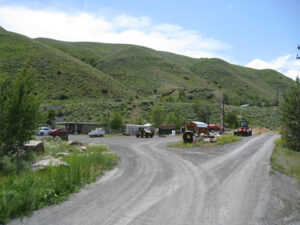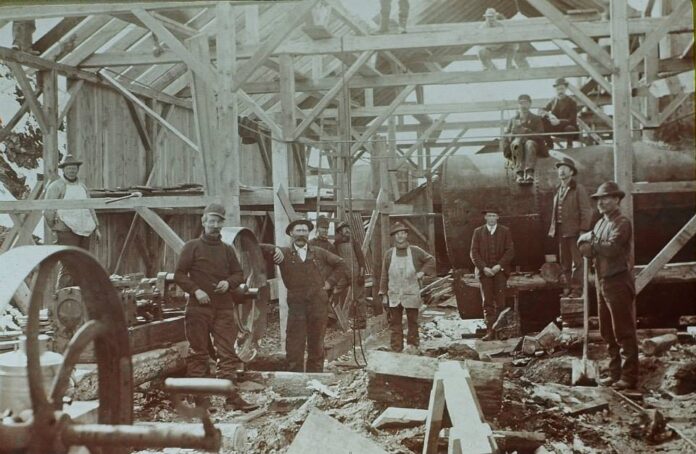Part 1 of a 2 part series.
BY KAREN CROWSON

Following the Boise Basin mining rush of 1862, an early stampede of prospectors began arriving in the Wood River in the spring of 1863, lasting until 1864, with many lead-silver prospects, but it wasn’t until 1879 that the development of mining began after the technology of that time had been worked out in Nevada and Colorado mines.
On July 15, 1879, the Queen of the Hills mine was discovered by Frank W. Jacobs. Jacobs was an original founder of the community of Jacobs City, near the Queen of the Hills mine. The Queen of the Hills mine lies in the Mineral Hill district. This district is in the vicinity of Bellevue and Hailey at the southern end of the Wood River mining area. Living in Jacobs City were M.H. Williams, David Whitmer, Frank W. Jacobs, William McWade, Sam Friend, and Jimmy Gray.
In 1880, Jacobs City was renamed Broadford, and now lies west of Bellevue, with current-day Broadford Road running through what once was the center of Broadford. Broadford had birthed as a necessity for serving the needs of the mines in the area, including the Queen of the Hills, and on September 22, a Notice Filed for Record for the Minnie Moore mine, discovered by Daniel W. Scribner, named the mine after his business partner’s daughter, Minnie Moore.
The Minnie Moore is 1.5 miles west of Bellevue at the mouth of Minnie Moore Gulch (formerly Galena Gulch) off Broadford Road and is on private property owned by Carl and Heather Johnston. Scribner credited the discovery of the Minnie Moore mine to a badger. Scribner’s partner, J.W. Moore, a prior Salt Lake City postmaster, sent Scribner out to search for a claim. After passing through Broadford, Scribner made camp at the mouth of the gulch and it’s from this point the discovery of the Minnie Moore has two accounts. The first is that Scribner’s horses escaped during the night and while Scribner was searching for them the next morning, he discovered the badger hole. The second account is Scribner’s dog chased a rabbit into the badger hole.
Upon the discovery of the badger hole, Scribner examined the rocks the badger had dug out and found galena, a lead-ore containing silver. Scribner began digging and discovered a vein of galena rich in silver. It is said that the badger hole was around 200 feet east of what would become the main shaft in the Minnie Moore mine.
After Scribner’s discovery of the badger’s discovery, Scribner sold his half interest in the mine to Henry E. Miller for $11,500 and, in August of 1881, Moore sold his interest in the mine for $50,000. This occurred at a time when factory workers made on average $10 a week.
With the Minnie Moore mine now added into the Mineral Hill district, the district became a predominant producer of zinc, lead and silver, with some production of gold. Gross production from this district in the Wood River Valley was estimated to be over $16 million.
After Scribner’s discovery, around 40 settlers arrived at Broadford to spend the winter scattered throughout the new mining region.
During the early 1880s, shipments from the Wood River mines was limited due to the hefty expense of wagon transportation and so the majority of mine operators and owners focused on the development of the mines while waiting for the railroad to be built up along the Wood River. It was during this period that David Faulk and Alonzo Wolters installed a smelter in Hailey, operating as the Wood River Smelting Company, and with the new smelter, production rose quickly, with ore being shipped to Hailey.
By winter of 1880, a promoter raised funds to finance a larger smelter, and on October 8, 1881, the Philadelphia Mining and Smelting Company opened for a 10-day test, and by 1882, the Wood River mines had produced over a million dollars’ worth of metals.
From 1880–1884, only surface mining occurred at the Minnie Moore mine, with the owners of the mine being Moore, Scribner, Miller and Grayson.
By 1884, Broadford had a population of around 600, with boarding houses, homes, stores and saloons, as well as the new Broadford Hotel managed by a Mrs. Galagher.
On February 25, 1884, Henry E. Miller sold the Minnie Moore mine for $450,000 to Dent, Palmer, and Company, of London, England, with ore reserves of $675,000 on site but with the price of silver declining from $1.50 an ounce in 1880 to $1.14 an ounce in 1884, when operating expenses exceeded profits.
Due to the decline of silver prices, mine owners began cutting costs, and on July 20, miners at the Minnie Moore held a strike that lasted 10 days until Superintendent Palmer met the demands of the miners with a settlement postponing wage reductions from $4 per day to $3.50 per day.
On January 20, 1885, Superintendent Captain Lusk of the Queen of the Hills mine asked the miners to take a temporary reduction in pay until lead and silver prices increased, which would have required the miners to work for $3.50 per day instead of $4. The miners refused and Lusk closed the mine and by February 4, miners at the Minnie Moore went on strike again due to lower wages.
On February 12, 12 men were charged with conspiracy in a complaint filed in the Probate Court of Alturas County. The 12 men charged were members of the Broadford Miners Union and were accused of unlawfully and fraudulently conspiring, with force and arms, feloniously and injuriously, to trade, to prevent any and all persons whomsoever from performing labor or mining, either for wages or by contract, or under lease, to either mine. The 12 men charged surrendered without force and the following day a preliminary examination of the 12 men began.
On February 23, Judge H.C. Street charged seven of the 12 with conspiracy and fined each man $500. Two days later, 14 other members of the BMU were arrested, with bonds set at $500. All 14 men paid in full and were released from custody.
On February 28, the Daily Times reported, “For some time past it has been evident that no men would be permitted to work in the mines at Broadford on any other terms than the payment of $4 per day wages, and that violence would be resorted to, if necessary, to prevent men from going to work, either on contract or for less than wages required by the Miners Union. This state of affairs caused considerable alarm in the community, and it became evident that something should be done to assert the supremacy of the law. The miners at Broadford, except on two or three occasions, had behaved remarkably well for men on a strike, and it was hardly deemed probable that they would openly defy the law; but, as there was a bare possibility that they might do so, the Sheriff moved to act by a requisition in due form, concluded to summon a posse to set to work what men were willing to work. The preparations—such as procuring badges, guns, ammunition, and appointing deputies—were completed last evening; this morning, the sSperintendents of the Queen of the Hills and Minnie Moore companies, having announced their working force ready, the Sheriff and his deputies marched to Broadford, escorting seven miners, which were all who were ready to go to work. The Sheriff’s force consisted of about 12 deputies from Hailey, and about 20 from Bellevue. All being ready, the force left the Minnie Moore office, in Bellevue, about half-past 11 o’clock and marched to Broadford. On arriving there, a crowd of men, numbering about 120, was seen standing on the sidewalk or in the street, by the side of the road. Of the men standing there, the majority were armed and kept their hands quite near their side and hip pockets; but they did not make any moves to use arms. It was evident, however, that they were determined, in case of an outbreak, to make a bitter fight. For a moment, the Sheriff’s force halted, and divided, one-half going to the Queen works, the other half to the Minnie Moore, where the men who wished to do so went to work. The Sheriff led the detail to the Minnie Moore and, after seeing the men to work, returned to the Queen, where he collected his force and marched it back to Bellevue, not one insulting word having been heard, not a blow offered. The Sheriff’s posse had been in Broadford just one hour.”
On March 17, during another miners’ strike, non-union men were attacked. The Daily Times reported on March 17 that, “the mine approaches were fortified, bulkheads of solid timber having been erected at all points easy of access. Behind these bulkheads deputies were stationed, who were armed with rifles and revolvers. There were probably 250 union miners in Broadford.”
The next day, acting Governor Curtis and General Brisbin, of the United States Army, arrived in Bellevue before making their way to Broadford to investigate the situation. After threatened military intervention, wages were reduced by 12 percent and within 60 days the union dissolved and wages became set at $3.50 per day. By June, a Grand Jury met, charging two union miners with a felony and charging another defendant with assault and battery. The defendant was fined $20 and plead guilty.
From 1886 until the closing of the Minnie Moore mine, in 1889, Dent, Palmer and Co. reported $1,433,306 in net smelter returns, $784,310 in operating expenses, $16,454 in new equipment costs and $6,725 in mining claims, leaving a profit of $625,865.
The closing of the mine was due to the vein abruptly ending at a fault. Attempts to locate the vein on the other side came up empty and so the mine was filled with water and lay idle until November 1900.



